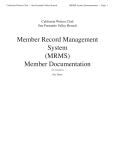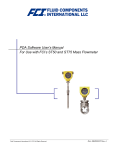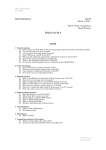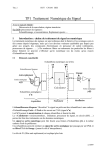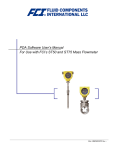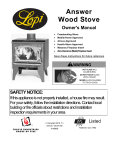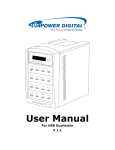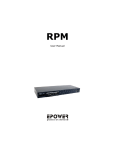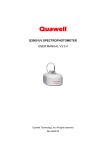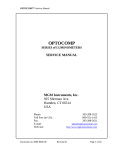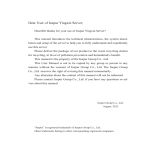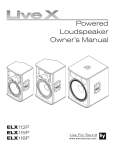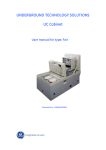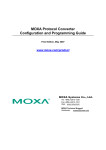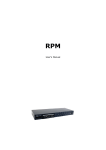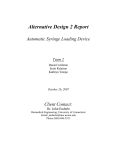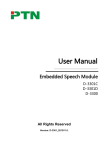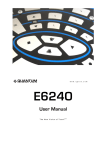Download P810P850 User Manual
Transcript
Contents I. APPLICATIONS................................................................................................... - 1 II. SPECIFICATIONS.............................................................................................. - 2 III. PRINCIPLES...................................................................................................... - 3 IV OPERATION....................................................................................................... - 9 V. MAINTENANCE ............................................................................................... - 21 VI SUPPLEMENT ................................................................................................. - 23 - Warning: The responsible person must be clear that the protective function of this instrument can be impaired if the method adopted by the user during the operation procedure is not the same as that specified by the manufacturer. Warning: All kinds of solvents should be placed with care during analysis procedure in accordance with the lab safety regulations. Refer to corresponding material safety data sheets whenever you need. Do wear lab coat, goggles and rubber gloves at any time. Care must be taken to avoid the possible burns whenever using hot reagents. Warning: Electric shock.The cover or plate should be removed only by the qualified personnel. I. Applications Polarimeter is the instrument used to measure optical rotation through which the concentration, content and purity of substances can be analyzed and determined, thus it finds wide applications in sugar making, medicine, petroleum, food, chemicals and other industries, as well as universities and research institutes. AP-81/85 automatic polarimeter (shortened as “instrument”) adopts LED as the light source to avoid frequent sodium lamp replacement. The instrument is equipped with built-in Peltier accurate temperature control system (available only in AP-85), which has heating and cooling functions. If temperature control tubes are utilized, the instrument can perform temperature control measurement towards sample optical rotation. -1- II. Specifications Measurement modes: optical rotation, specific rotation, concentration, sugar degree Light source: LED Working wavelength: 589.3nm (sodium D spectrum) Measurable sample minimum transmittance: 1% Measuring range: ±45° (optical rotation) Minimum reading: 0.001° (optical rotation) Value error: 0.01(full scale) Repeatability: (standard deviation): 0.002° (optical rotation) Temperature control range: 15℃-30℃ (only applicable to P850) Temperature control stability: ±0.1℃ (only applicable to P850) Temperature control accuracy: ±0.3℃ (only applicable to P850) Resolution: ±0.1℃ Display modes: 5.6 inches, 640×RGB×480 resolution, 65K color, real color TFT, touch screen, large screen liquid crystal display Tubes: Normal type 200mm, 100mm; Temperature control type: 100mm (only available in AP-85) Output communication interface: USB and RS232 serial interface are offered in the screen menu Power supply: AC 220V±22V, 50Hz±1Hz, 250W Dimension: 708mm×330mm×287mm Net weight: AP-81 24Kg AP-85 26Kg -2- 2. Basic Application Principles As it is known to all, the visible light, which is usually referred to as the natural light, is actually the electromagnetic wave of which the wavelength is among 380nm~780nm. In terms of statistical law, the corresponding light vibration spreads in all directions vertical to the direction of the light propagation, and the corresponding amplitudes (light intensity) of the light vectors are equal. If the vibration direction is fixed to be vertical to the light propagation direction using certain devices (such as polarizer), then the so called plane polarized light is formed. The polarized light changes in vibration direction as it goes through certain substance, which is called optical active substance and the changed angular is called optical rotation. When the plane polarized light goes through certain pure optical active substance, optical rotation is decided by the following three factors: (a) The wavelength λ of the plane polarized light, different λ leads to different optical rotation. (b) The temperature t of the optical active substance, different t leads to different optical rotation. (c) The type of the optical active substance, different type has different optical rotation. A C' D' t t t B' -90° The term α+α ' D 0 α' B β β t +90 ° α+α' C β β β β 图1 called special optical rotation is used to represent the optical rotatory power. It is a general rule that the optical rotation measured under the following conditions is the special optical rotation of the substance, the conditions include: the length of the polarimeter tube is 1dm (100mm), the test solution concentration is 1g/ml, the temperature is t℃ and the wavelength of the plane polarized light is λ. As the special optical rotation is only determined by the substance structure, it is a physical constant unique to the material. α λt = [α ]λ • L • C t (1) -4- Where L is the length of test solution (polarimeter tube) and is measured in millimeter; C is the concentration of optical active substance in the test solution. It is usual for the instrument to display the weight of the optical active substance in each 100ml solution. If the special optical rotation [α ]λ of the test substance is given, then optical t rotation α λt can be measured under certain wavelength and temperature; if the length of the test solution is L, the concentration C of the optical active substance can be figured out according to formulation (2). C= α λt [α ]λt ⋅ L (2) If there is non-optical active substance in the solute, the content or purity of the optical active substance can be obtained from concentration of the mixed solution and concentration C obtained by formulation (2). 3. Optical Null Principles If the natural light goes through a polarizer and an analyzer in turn, the place, where the light through the polarizer and the analyzer is orthogonal, is taken as the null. According to the Malus law, the relation between α, the angular between the analyzer and the orthogonal position, and I, the incidence light intensity of the analyzer, is I=I0COS2α , shown as the curve A in Fig.1 -5- A D' C' t t -90° α +α' D 0 B β β B' t t +90° α' α+α ' C β β β β 图1 When a sinusoidal alternating voltage u=Usin2πft of the frequency f is imposed on the two terminals on the Faraday coil, according to the Ferrari magnetic-optic effect, the vibration plane shall be superimposed an additional rotation angular: α1=β·sin2πft. When there is a Faraday coil between the polarizer and the analyzer, the emergent light intensity signals of the analyzer are shown as follows: (a) B and B′ curves in Fig.1 are obtained when the vibration plane is at orthogonal position. The light intensity signal, which is shown as the curve B′, is formed by a certain constant light intensity and an alternating light intensity of the frequency 2f superimposing on the constant light intensity. (b) C and C’ curves in Fig.1 are obtained when the vibration plane is at rightward of the orthogonal position. The light intensity signal, which is shown as the curve C’, is formed by a certain constant light intensity and an alternating light intensity of the frequency f superimposing on the constant light intensity. (c) D and D’ curves in Fig.1 are obtained when the vibration plane is at leftward of the orthogonal position. The light intensity signal, which is shown as the curve D’, is formed by a certain constant light intensity and an alternating light intensity of the frequency f superimposing on the constant -6- light intensity. The phase of this alternating light intensity is opposite to that of the alternating light intensity when the vibration plane is at rightward of the orthogonal position. Therefore, we can decide whether the analyzer and the polarizer are at orthogonal position by determining whether the alternating light intensity of the f component is zero. Similarly, we can decide whether the analyzer is at rightward or leftward of the orthogonal position by determining the phase of the alternating light intensity. 4. Instrument Structure 12 11 10 9 8 7 6 5 19 4 3 2 1 17 13 20 14 22 18 21 16 23 15 1. LED 2. Diaphragm 3. Condenser 4. Polarizer 5. Modulator 6.Collimating lens7. Tube 8. Analyzer 9.Objective lens 10. Filter 11. Diaphragm 12. Photomultplier 13. Automatic high-voltage 14. Pre-amplification 15. Motor control 16. Servo motor 17. Mechanical drive 18. Rotating code count 19. Heating and cooling 10. Temperature control 21. SCM control 22. Liquid crystal display 23. Light source and power source -7- Instrument structure is shown in Fig.2. The light sent by the LED in turn goes through the diaphragm, the condenser, the polarizer, the Faraday modulator and collimating lens, and finally turns into a collimating plane polarized light whose vibration plane varies with the alternating voltage of the Faraday coil. Then the polarized light goes through the test solution tube, the analyzer, the objective lens, the filter and the diaphragm, and finally turns into a monochromatic light whose wavelength is 589.3nm. After this, the light goes into the photomultiplier, which transforms the light intensity signals into the electrical signals, and is amplified by the pre-amplifier. Automatic high-voltage automatically changes the photomultiplier high-voltage according to the incidence light intensity of the photomultiplier as to measure the brunet samples with low transmittance. If the analyzer deviates from the orthogonal position compared with the incidence polarized light plane, the alternating light intensity signal of the frequency f is able to pass through and then transformed into the electrical signal of the same frequency by the photomultiplier. After this, the electrical signal goes through in turn pre-amplifier, motor control, frequency-selecting, power amplifier and then drives the servo motor to turn the polarizer through mechanical drive. When the polarized light plane of the polarizer is orthogonal to the analyzer, the electrical signal of the frequency f disappears and the servo motor stops. When the instrument begins to work properly, the polarizer automatically turns and stops at the orthogonal position (defined as the null) according to the previous process, then counter is reset. For example, if the tube with the sample, whose optical rotation is α, is placed into the sample room, and the incidence plane polarized light derivates α from the orthogonal position, thus the polarizer repeats the previous process--- turning the polarized light of α and reaching the orthogonal position. The coded disc counter and SCM circuit then change α, of which the polarizer turns, into optical rotation and -8- display the measurements on the liquid crystal display. The instrument is equipped with temperature controller, which can control sample temperature. Temperature control polarimeter tube shall be utilized when temperature control is needed. The actually measured polarimeter tube temperature by the platinum resistor is input to the SCM. Then the temperature value is displayed by the liquid crystal display, meanwhile the temperature control signal is sent to the temperature control circuit to control the heating or cooling of the semiconductor cooler, so the temperature of the polarimeter tube is kept around the setting value. Besides, you can decide whether the temperature control is needed by pressing the buttons in the liquid crystal display at any time. IV Operation 1. Use Conditions 1.1. The instrument should be mounted on the stable workbench to avoid vibration. At least 10cm must be guaranteed between the instrument and surrounding walls for prompt heat dissipation. 1.2. The instrument should be kept away from humidity and corrosion of the corrosive gas to stay dry, and it is best to use the instrument in the 20℃ working environment. 1.3. The instrument power supply should be the alternating current power supply with 220V, 50Hz (AC electronic voltage stabilizer is useful if the voltage is unstable). Insert the power plug into the power socket and guarantee the ground pins are firmly grounded. 2. Operation 2.1. Main Interface After the instrument starts, wait for a few seconds to see the window form of the main interface in the screen, as shown in Fig.1: -9- Fig. 1(AP-81 interface) Fig. 1(AP-85 interface) You can set the corresponding parameters in this window. Instructions to function keys in the main interface as shown in Fig.1: Re-measure: measures again Reset: sets data to zero - 10 - Mode: offers four modes of optical rotation, specific rotation, concentration, sugar degree, as shown in Fig.2 Parameter: sets the parameters used during measurement, as shown in Fig.3. Data: stores, checks and sends the measurements Help: offers some notices in operating the instrument About: offer 400 service telephone and website 2.2. Mode Interface After you press Mode, the following appears, as shown in Fig.2: Fig. 2 In this interface, press each icon keys of all modes to choose the needed measure mode. After choosing the mode, press Confirm to return to the main interface. 2.3. Parameter Interface After you press the Parameter, the following appears, as shown in Fig.3 - 11 - Fig.3 2.3.1. Instructions to function keys in the main interface in Fig.3: Measurement Times: times of instrument to re-measure automatically Sample No.: sets numbers for the samples Tube Length: inputs the tube length, which must be done in special optical rotation and concentration modes. Special Optical Rotation: inputs sample optical rotation, which must be done in concentration mode Instrument Calibration: is used in the instrument internal debugging before factory. Concentration: inputs sample concentration, which must be done in special optical rotation mode Communication Method: chooses USB or RS322 serial communication Date and Time: sets current date and time Temperature Setting: sets control temperature, opens or closes temperature control (only available in AP-85) 2.3.2. Instructions to interface functions in Fig.3: There are setting buttons corresponding to the parameters in this interface. - 12 - After touching key, you enter into the parameter digital setting interface. For example, after you click Measurement Times, the following interface appears, as shown in Fig.4: Fig.4 After you press the corresponding digital buttons in this interface, the digit that needs to be set appears. After you have completed the settings, press Confirm to go back to the previous interface and then press Back to go back to the main interface. The parameter setting process such as Sample No., Tube Length, Optical Rotation, Concentration, Communication Method as well as Date and Time are the same with Measurement Times process: click the button to go to the corresponding interface, press the digit to complete setting, and return to the main interface successively to carry out measurement. Among the above settings, the Temperature Setting (only available in A P-81) and Instrument Calibration are done in the instrument internal debugging before factory, so there is no need for user to set. Note: In the special optical rotation mode, Concentration and Tube Length must be set; in the Concentration mode, Special Optical Rotation and Tube Length must be set. - 13 - (AP-85) If sample needs to be measured in the temperature control mode, the temperature control polarimeter tube must be utilized. Click Temperature Setting to enter the corresponding interface, as shown in Fig.5: Fig.5 Temperature Setting: sets the temperature at the desired value. After you click Temperature Setting, the interface goes to temperature setting interface where you can set the desired temperature and press Confirm to complete setting. Temperature Control Switch: chooses to open or close thermostatic function. Temperature Calibration: is used for the temperature sampling before factory, so user does not need to set. Put the sample into the tube, and make sure there are no bubbles in the tube. After putting the temperature control tube with the sample into the sample room and pressing the thermal conductive plane of the tube against the heat transfer plane of the sample room, insert the temperature probe into the thermometer hole of the tube and close the sample room. Note: the temperature probe must be inserted into the thermometer hole of the tube to guarantee smooth temperature control. After above, the sample temperature begins to move toward setting - 14 - temperature and finally reaches the setting value. After the temperature is stable, re-measure for several times to ensure the correctness of the measurements. Enter into the temperature control interface and click Close Temperature Control before removing the tube or there is no need to conduct measurement. 2.4. Digital Interface After you press Digital Graph, the following interface appears, as shown in Fig.6: Fig.6 Press Current Data to check the current test data; press History Data to check the previous test data. After you press Current Data, the following interface appears. - 15 - Fig.6-1 When checking the current test data, you can press Send to send the data to the upper computer and press Save to save the current data. After you press History Data, the following interface appears, as shown in Fig.6-2 Fig.6-2 You can check the history test data, and press Send to send the data to the upper computer. - 16 - 2.5. Help Interface After you press Help, the interface appears, as shown in Fig.7: Fig.7 2.6. About Interface After you press About, the interface appears, as shown in Fig.8: - 17 - Fig.8 3. Recommended Operation Process of Sample Measurement (1) Place the tube with instilled water or blank solvent into the sample room, close the sample room, and press Reset. Then zero appears on the display. If there are bubbles in the tube, make them float at raised neck of the tube; if there are fog water drops at both ends of the smooth surface, wipe up with a soft cloth. Tube nut should not spin too tightly or the stress would be raised affecting the reading. Pay attention to the mark, position and direction when placing the tube. (2) Remove the tube. Inject the test sample into the tube, place it into the sample room at the same position and direction, and close the lid. The optical rotation (or corresponding indicating value) is displayed. (3) The instrument sets automatic measurement n times, so n readings are obtained and average value is displayed. If Measurement Times is set one, you can re-measure manually by pressing Re-measure. If the process shall be re-measured more than one time, press Re-measure to clear the previous measurements and measure successively n times. (4) Press Reset before each measurement. (5) Disconnect the power after use. - 18 - 4. Method of Building Communication between Instrument and PC 4.1. Build Communication through Serial Port (1) Firmly connect the RS232 communication cables before starting up; (2) Choose the COM communication mode in the parameter setting of the polarimeter. (3) Open the “Blue Sea Series” upper computer software in the PC, select COM and click Connect. (4) After you press Send during the measuring process, the data appears in the display interface. 4.2. Build Communication through USB (1) Firmly connect the USB communication cables before starting up; (2) Choose the USB communication mode in the parameter setting of the polarimeter. (3) Open the “Blue Sea Series” upper computer software in the PC, select USB and click Connect. (4) After you press Send during the measuring process, the data appears in the display interface. 4.3. Upper Computer Communication The communication software interface of the upper computer is shown in Fig.9: - 19 - Fig.9 Instructions to keys in Fig.10 Connect: is clicked after COM, USB communication connecting method is confirmed Save Data: Delete Selected Data: Print Data: Clear All Data: You can save, print or delete the test data transmitted from the instrument. 4.4. Use EXCEL document or text document to save data. (1) Calculation formulation of the special optical rotation is [α]=100α/LC Where α is the measured optical rotation (grad). C is weight (gram) of test material in every 100ml solution L is the solution length (dm) The special optical rotation can be measured according to the mode 2 operation. - 20 - (2) Purity of the material can be figured by the measured special optical rotation: Purity=actually measured special optical rotation/ theoretical special optical rotation (3) Computational rules of measuring international sugar content: According to the international sugar degree standard, it is manipulated that the optical rotation of the 100ml solution in the 2dm tube with 26g pure sugar is +34.626° and its sugar degree is 100°Z measured by sodium light in 20℃. This instrument adopts mode 4, so the international sugar degree can be read directly. V. Maintenance 1. The instrument should be kept away from humidity and corrosion of the corrosive gas to stay dry, and it is best to use the instrument in the 20℃ working environment. 2. The polarimeter tube should be wiped with soft cloth to keep clean before placed into the sample room and avoid corrosion of the corrosive gas. - 21 - Fault conditions Possible cause Actions to take 1. Exchange the power switch or Power is turned on, but lights are off. 1. Damaged power switch; 2. Damaged LED; 3. Burned-out 2A fuse. return it to the factory for repair; 2. Exchange the light source or return it to the factory for repair; 3. Replace the 2A fuse. 1. Excess contact Touch screen does not respond between color 1. Reduce the contact with the screen touch area and shell; color screen touch area; 2. Check whether there are 2. Color screen quality quality problems. problems. 1. The encoder cable Counter does not work. plug off; 2. Check the power; 2. Whether the encoder power is normal. The instrument cannot be connected with PC. 1. Insert the plug; 1. Damaged USB cables; 2. On-line program errors. - 22 - 3.Return it to the factory for repair. 1. Check the cable and make sure soldering is intact; 2. Contact the manufacturer. VI Supplement Since the date of sale (starts from the date of invoice), this product is guaranteed for one year, but the following conditions are not within the scope of the warranty: 1. Over warranty period; 2. Instrument damage due to improper use; 3. Instrument damage due to disassemble without manufacturer’s permission 4. Instrument damage due to improper transportation and storage. - 23 -



























